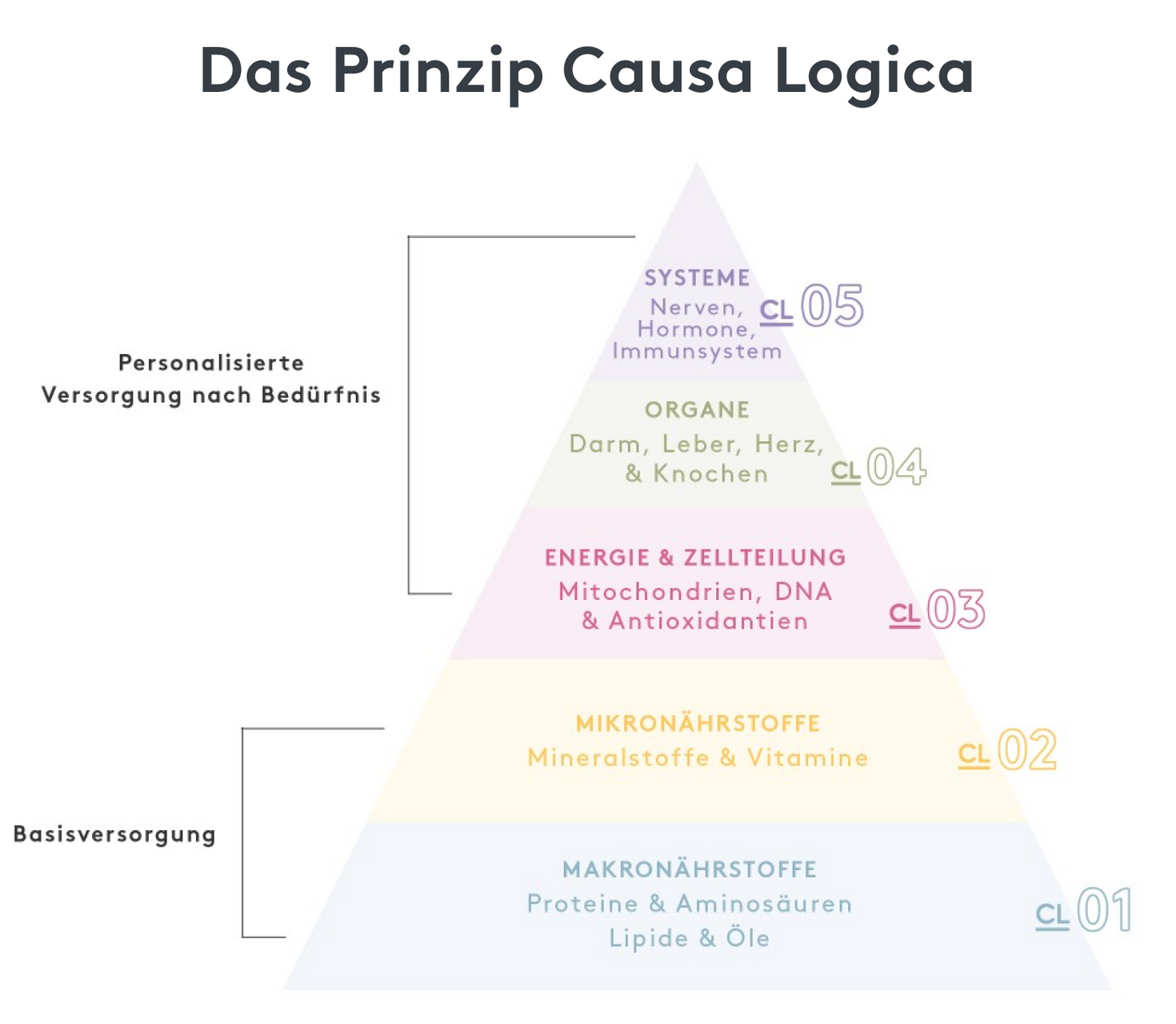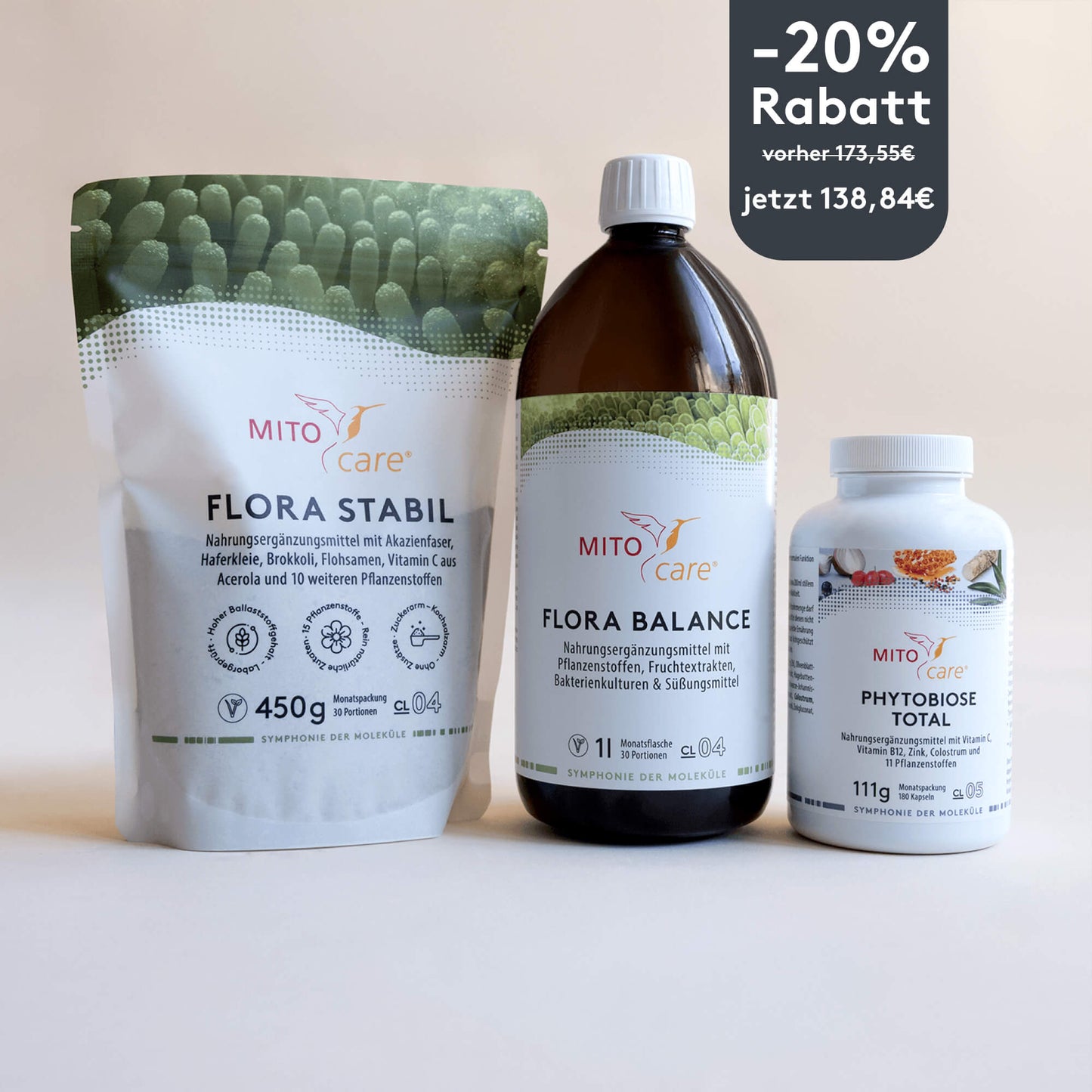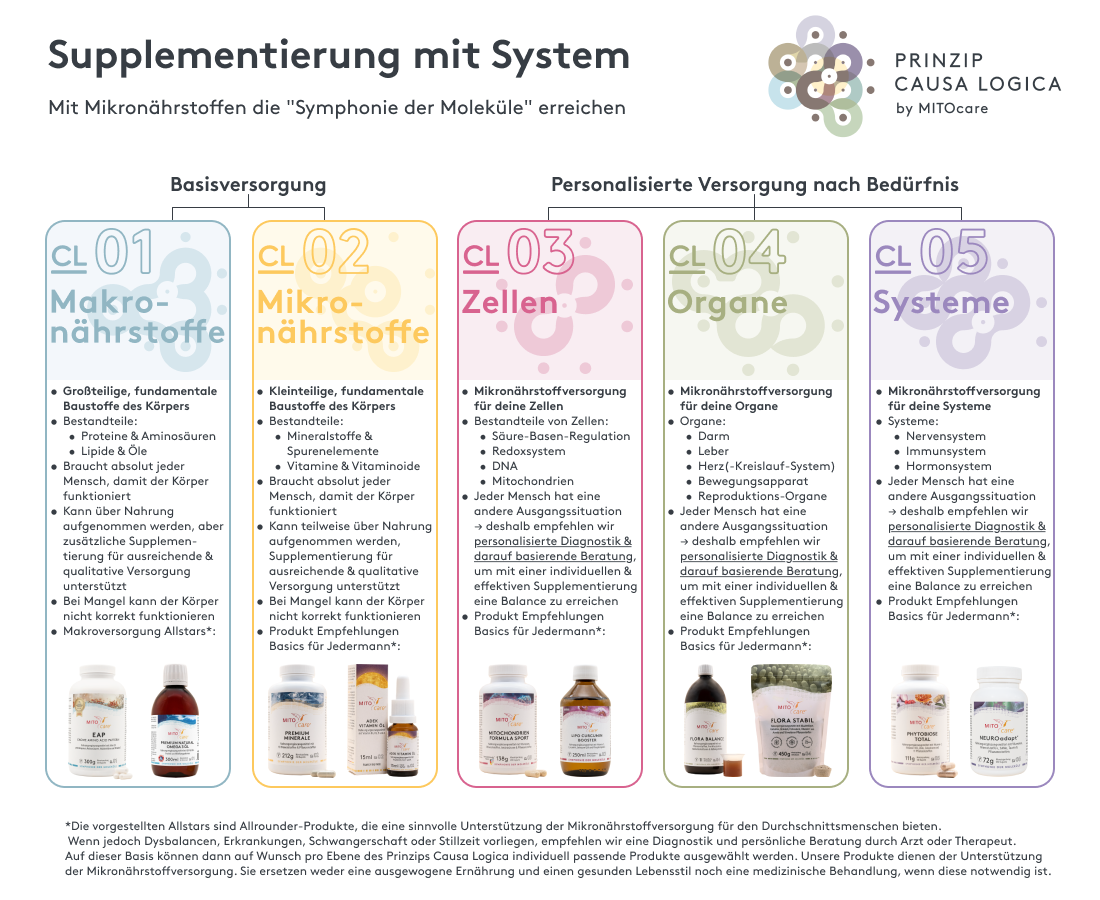Themen dieses Blogartikels:
Table of contents
- Principle of Causa Logica explained simply
- What makes the PCL unique?
- 5 levels of care of the PCL
- CL1: Macronutrients
- CL2: Micronutrients
- CL3: Cell level
- CL4: Organ Level
- CL5: System Level
- Basic care: The foundation
- Basic nutrition: Which vitamins and minerals does everyone need?
- Complexity of the application
- Basic nutrition & micronutrients explained
- Why a strong basic healthcare system is crucial
- Personalized diagnostics & expert support
- Our vision at MITOcare
- Premium quality through knowledge, experience & responsibility
- Research & Innovation
- Your guide through the jungle of micronutrients.
- Sources & Bibliography
Introduction
The market for nutritional supplements is booming – and with it, uncertainty. Everywhere you find new "miracle cures," recommendations, and trends that often create more confusion than clarity. Which micronutrients are truly essential for basic nutrition? And when does it make sense to supplement in a targeted and personalized way?
This is precisely where MITOcare comes in: With the Causa Logica principle , a system has been developed that brings structure to supplementation – scientifically sound, practical and holistic in its approach. It serves as a guide for both users and professionals such as therapists or doctors to use micronutrients purposefully and effectively.
Another advantage: The supplements associated with the Causa Logica principle consist of complex products . Each formula combines several carefully selected active ingredients that are optimally coordinated – in dosage, function, and effect . This answers the question " What can I combine and how?" right from the product development stage. The result: holistic, synergistic formulas that avoid over- or under-dosing and support the body on all levels.
In this blog article, we explain how the Causa Logica principle works, what every person really needs as basic nutrition – and when individual diagnostics are the key to an optimal micronutrient strategy.
The body as a networked system: The principle of Causa Logica explained simply.
The Causa Logica principle was developed in 2013 by doctors and experts – based on the interplay of natural science, scientific research and practical experience. Since then, it has been continuously developed further, based on the latest findings in medicine, biochemistry and nutritional science.
As a guideline for systematic supplementation , the principle helps to structure the world of micronutrients in a comprehensible and logical way . It is based on the body's blueprint and transfers the natural synergy effect of nature – in which everything is interconnected – to micronutrient supply. This creates a clear system that addresses causes rather than symptoms and aims to bring all processes in the body into balance.
What makes the Causa Logica principle unique?
The Causa Logica principle pursues two central goals: Firstly, it aims to help promote balance in the body – the so-called "symphony of molecules" . This describes the ideal state in which all cells work together harmoniously and biochemical processes interlock smoothly.
By purposefully adding thoughtfully combined micronutrients , where each substance interlocks like gears, this inner order can be specifically supported. Because in nature, no nutrient acts in isolation: An apple doesn't just provide a single vitamin, but a whole interplay of vitamins, minerals, enzymes, and plant substances that mutually reinforce each other. This principle of synergy forms the basis of the Causa Logica principle – an intelligent, systemic form of supplementation that strengthens the body's balance.
On the other hand, the principle serves as a guide – both for users and for professionals. The market for nutritional supplements is confusing, and recommendations are often contradictory. The Causa Logica principle creates structure and answers key questions: Which micronutrients form the basic supply? When is targeted supplementation useful? And how can systematic supplementation be effectively integrated into everyday life?
To achieve these goals, MITOcare develops high-quality micronutrient complexes that are precisely structured according to this principle. They consist of premium raw materials, are optimally bioavailable, precisely dosed, and perfectly coordinated in their active ingredients – without unnecessary additives . Even in product development, consideration is given to which nutrients can be combined effectively to avoid over- or under-dosing . The result is a holistic, scientifically sound supplementation that supports the body.
All MITOcare complex products are based on this principle. The Causa Logica principle provides orientation, promotes understanding and shows how systematic supplementation leads to sustainable balance and holistic health.
The 5 levels of care of the Principle of Causal Logic at a glance
The Causa Logica principle divides micronutrient supply into five logically coordinated levels (CL01–CL05). These levels are based on the natural structure and functional interrelationships of the body – from the basic building blocks to the complex control systems.
The lower half of the pyramid forms the basic care that every person needs to maintain all elementary bodily functions. The upper levels provide personalized care based on individual needs , specifically addressing organs and systems.
This creates a clearly structured model that shows how all processes in the body interact – and how a systematic, synergistic supplementation can support the natural balance, i.e. the "symphony of molecules" .
The following section explains the five levels of the Causa Logica principle in detail – from the basic level to the individual care level.


CL1: Macronutrients – Foundation & Structure
This foundation includes proteins and fats as essential building blocks. They provide calories, but above all, the material for cells and tissues. Proteins consist of amino acids, the basic building blocks of all enzymes, muscles, and tissues.² Without enough protein, for example, new cells cannot be built or hormones and enzymes formed. Fatty acids – especially omega-3 fatty acids – are elementary components of cell membranes . They keep our cells flexible and functional.¹ Omega-3 integrates into the cell membrane and contributes to membrane fluidity¹, which is important for nutrient transport and cell communication. (Fun Fact: Even our brain consists largely of fat – DHA , an omega-3 fatty acid, is abundantly present there.)
Advertisement
- 300 ml Premium Natural Omega 3 Oil from sustainable wild catch
- 1460mg EPA and 910mg DHA
- Natural 1.6:1 ratio
- Fatty acid complex consisting of 27 fatty acids
- Citrusy, pleasant taste, no fishy taste.
- Total oxirane value of <10 & cleaned of heavy metals & Co
- Laboratory tested
- Developed with doctors & experts

CL2: Micronutrients – Vitamins & Minerals for all processes
These include vitamins, minerals, and trace elements. These small helpers control countless metabolic functions as co-factors. Vitamins, for example, are important for the immune system, cell division, energy production, and much more. Vitamin C, for example, contributes to the normal function of the immune system.³ Minerals are involved in muscle function, bone health, and nerve conduction, for example. One example: Magnesium is indispensable as a cofactor in over 300 enzymatic reactions, including energy metabolism and DNA synthesis.⁴ Without micronutrients, many "gears" in the body don't function properly. Since we cannot produce vitamins and minerals ourselves, they must be regularly supplied from external sources.
Advertisement
- 40 bioactive premium active ingredients – everything your mitochondria need as fuel.
- Supports cellular energy, energy levels, performance and efficiency.
- Unique complex developed by our team of doctors and experts.
- Contains vitamins, minerals, amino acids, medicinal mushrooms & many other premium active ingredients.
- No additives or fillers.

CL3: Cellular Level – Energy, Protection and Regeneration
This level concerns the supply of nutrients to our cells and cell components. This includes, for example, nutrients for the mitochondria (our cells' "powerhouses"), for DNA synthesis and cell division, as well as antioxidants for cell protection. Antioxidants such as Vitamin E help protect our cells from oxidative stress caused by free radicals.5 This protects cell membranes and DNA from damage. Similarly, the cell needs sufficient B vitamins , for example, for energy production (such as Vitamin B1, Vitamin B2 , Vitamin B3 , Vitamin B5 as coenzymes in the citric acid cycle) and for DNA repair (folic acid, B12 ). At this level, micronutrients ensure that each individual cell has enough energy and remains intact.
Advertisement
- Individual micronutrient needs based on your DNA.
- Analysis of 43 gene variants from 38 genes
- Simple & convenient through saliva test - directly from home.
- Targeted supplementation - Vitamins, minerals & antioxidants that you really need.
- Takes genetics and environmental factors into account - scientifically sound.
- Clearly understandable results & expert recommendation included.

CL4: Organs – Targeted support for the "organ systems"
This level includes nutrients for central organs and tissues such as the intestines, liver, heart, blood vessels, bones, muscles, and connective tissue. Each organ has specific functions – and accordingly specific nutrient needs. For example, healthy bone tissue requires sufficient calcium and vitamin D. Both nutrients are essential for maintaining stable bones.⁶ Calcium strengthens bone substance, and vitamin D promotes calcium absorption and bone health – together they are indispensable for bone density. For the cardiovascular system, magnesium and potassium (for muscle and heart function), omega-3 fatty acids (for heart health), and antioxidants (for vascular protection) play a role, among other things. The liver and digestion benefit from bitter substances, sulfur-containing compounds (for the body's own detoxification), and probiotics/fiber (for a healthy intestinal flora). You can see: Each organ has its "favorite nutrients", and PCL specifically takes these into account.
Advertisement
- Daily routine for the gut and immune system
- Flora Balance with 27 probiotic bacterial strains
- Flora Stabil with 30g fiber & 14 plant substances, for the intestinal flora and the microbiome
- Phytobiose Total with 11 other valuable plant substances for the immune system
- Developed with doctors & experts

CL5: Systems – Hormones, Immune System & Nervous System
At the highest level, entire body systems are the focus, such as the hormone system , the immune system , and the nervous system . For these complex systems to function optimally, all previous levels must be well-supplied. Furthermore, specific micronutrients are also important here: For a strong immune system, for example,Vitamin C , Vitamin D, and zinc are known – they contribute to normal immune function (Vitamin C/D) or to the protection of cells (zinc as an antioxidant). The nervous system requires sufficient B vitamins (especially B1, B6, B12) for nerve impulse conduction and neurotransmitter formation. Omega-3 (DHA) also plays a role here, as it contributes to the maintenance of normal brain function (with sufficient intake). In the hormone system, iodine and selenium are important for the thyroid gland, and amino acids such as tyrosine are building blocks for thyroid and stress hormones. In conclusion: All systems are interconnected – and PCL ensures that the necessary building blocks are available at every level so that the entire "body structure" remains stable and in harmony.
These five supply levels (CL1–CL5) form the core concept of the Causa Logica Principle. They clearly demonstrate the holistic thinking behind PCL : Nothing is considered in isolation, from the basic macronutrients to the complex body systems. All levels interact, and the PCL concept ensures that your body is optimally supplied at all levels . This sophisticated system has been developed and continuously refined over a decade – a true symphony orchestra of micronutrients playing in harmony for your well-being.

Basic care (CL01 + CL02): The foundation of your health
Having understood the principle, we now delve deeper into basic nutrition , namely the first two PCL levels CL1 (macronutrients) and CL2 (micronutrients) . They form the foundation upon which everything else is built. A strong basic nutrition means that every person – regardless of age or lifestyle – is adequately supplied with the most important nutrients. This basic supply is crucial, especially for health-conscious people (particularly women over 40), to remain vital and fit.
When manufacturing dietary supplements, it is particularly important to comply with legal requirements and high quality standards in order to ensure food safety and effectiveness.
Advertisement
- 20 amino acids, supplemented by nucleotide complex – tailored to your genetic blueprint
- High bioavailability due to enzymatically digested amino acids
- Exom Match: Our composition is based on the protein structure of your body
- Tasteless & versatile
- Human Amino Acid Signature – for specific composition & innovation

Basic nutritional support with dietary supplements: Which vitamins and minerals does everyone need?
While our modern diet offers an enormous variety, studies show that many people are still not optimally supplied with all essential nutrients. Vitamins and minerals that the body needs daily are often lacking – whether due to an unbalanced diet, nutrient losses during preparation, or increased needs (e.g., during stressful times or with increasing age). Targeted basic supplementation with nutritional supplements can help close these gaps and meaningfully supplement the diet.
But first: Which vitamins and minerals does everyone need? – The short answer: All essential ones! Specifically, these include 13 vitamins (A, C, D, E, K and 8 B vitamins) as well as numerous minerals and trace elements (e.g., calcium, magnesium, potassium; iron, zinc, selenium, iodine, etc.). These micronutrients are essential because the body cannot produce them itself – we must obtain them through food (and possibly supplements).
Each of these micronutrients performs specific tasks in the body:
Complexity of the application
Important: Everyone needs all these vitamins and minerals – however, the amounts vary slightly depending on age, gender, and lifestyle. For example, a 45-year-old woman has a higher iron requirement than a man of the same age (due to menstrual blood loss until menopause). Conversely, men often need slightly more magnesium . However, the basic principle applies: A deficiency of one of these essential micronutrients can lead to functional disorders in the long term. Examples include fatigue due to iron or B12 deficiency, susceptibility to infections due to zinc or vitamin D deficiency, muscle cramps due to magnesium deficiency, etc. These symptoms develop gradually but are warning signals from the body. Therefore, it is so important to ensure basic supply.
Unfortunately, the reality is often such that even in industrialized nations, many people do not reach the recommended intake levels. Protein and certain micronutrients are particularly critical : Studies show that up to 46% of older adults do not even reach the recommended daily protein intake of 0.8 g per kilogram of body weight⁷ – meaning that almost half of seniors consume too little protein to maintain their muscles and organs. Similar situations exist with Vitamin D (insufficiently produced, especially in winter), folate (B9), and iron (common deficiencies in women).
This is where basic nutritional supplements come into play. They provide the vitamins and minerals everyone needs in concentrated form – regardless of individual needs. Products based on the PCL principle go a step further: they combine several of these basic micronutrients in a meaningful way to utilize synergies. For example, holistic basic supplements often contain a mix of vitamins and minerals, sometimes supplemented with essential fatty acids or amino acids, to truly cover the entire foundation.
💡 Tip: In our knowledge blog you will find detailed articles on the most important nutrient groups. Feel free to take a look to learn more about omega-3 fatty acids , amino acids , vitamins and minerals. There you will find explanations of why these nutrients are so important and how you can optimally absorb them.
Which vitamins does everyone need? Basic supply & micronutrients explained.
We have essentially already answered the above question: everyone needs all essential vitamins. However, let's take a more systematic and practical look at the most important micronutrients, especially with regard to what basic supplementation can achieve:
- Multivitamins/Multi-minerals: A good multivitamin supplement can cover the basic supply of vitamins (A to K) and usually some minerals in a daily dose. It doesn't replace a balanced diet, but it acts as a safety net if the daily diet is deficient. It's important that the dosages remain moderate (based on reference values) and that there are no overdosed extremes – PCL products pay close attention to using regulatorily compliant and sensible amounts. By combining several vitamins and minerals in one product, interactions are also considered: For example, vitamin C promotes iron absorption, vitamin D promotes calcium absorption, etc. In the "orchestra," they work together instead of playing alone.
- Vitamin D and Omega-3 as special cases: These two are on everyone's lips because almost everyone can benefit from supplementation here. Vitamin D is mainly formed in the skin through sun exposure – many people (especially in our latitudes) have a deficiency in the dark months. A daily basic intake of, for example, 1000–2000 IU of vitamin D3 is often recommended (depending on the individual level, of course). Omega-3 fatty acids ( EPA and DHA ), on the other hand, are almost exclusively absorbed through fatty fish or algae – those who rarely eat fish often have a suboptimal omega-3 status. These fatty acids are not only components of cell membranes, but are also known for their positive effects on the heart and blood vessels. Studies show that omega-3 supplements (fish oil) can support heart health – for example, with sufficient dosage, they reduce the risk of fatal cardiovascular events.⁸ That's why vitamin D and omega-3 are simply part of the " basic supply " for many.
- Magnesium , Calcium & Co.: Minerals are at least as important. If they are lacking, for example, energy metabolism doesn't function properly (Magnesium), muscles malfunction (Calcium, Potassium, Magnesium), or the immune system is weakened (Zinc, Selenium). We've already mentioned Magnesium – it's involved in hundreds of enzymatic reactions.⁴ We mentioned Calcium and Vitamin D as a duo for bones.⁶ Zinc , along withVitamin C , supports the immune system and wound healing; Selenium, as a component of important antioxidant enzymes, protects our cells; Iodine is necessary for thyroid hormones, etc. A basic supply should include an adequate amount of these minerals. Often, these substances can be covered quite well through diet (e.g., Calcium through dairy products, Magnesium through nuts and vegetables). Nevertheless, it applies: With a one-sided diet or increased need (stress, sport, pregnancy, menopause, etc.), supplementation can be useful.
In conclusion to the question "Which vitamins (and minerals) does everyone need?": There is a defined list of essential micronutrients that applies to everyone. The art of good basic nutrition lies in providing these in the right balance. Because too little is problematic – but taking far too much of individual nutrients is also not sensible. The PCL concept ensures a harmonious ratio : All necessary substances are included, but there is no overdose or imbalance that would disrupt the delicate balance. This ensures your body is comprehensively supplied without overloading it.
To help you keep track of which vitamins to combine and how, we recommend taking a look at our Vitamin Guide.
Why a strong basic healthcare system is crucial
One might ask: Do I really need this? Isn't "eating reasonably well" enough? – Experience and science show: A solid basic supply is the key to sustainable well-being. Why? Here are the most important reasons:
- Prevention instead of repair: If your body continuously receives all the necessary micronutrients, many problems can be prevented from arising in the first place. For example, with sufficientVitamin C , D, zinc & protein, your immune system has the best chance of warding off pathogens – infections have a harder time¹. Your bones remain stable with enough calcium, vitamin D & K – the risk of osteoporosis decreases¹. Your energy metabolism runs smoothly with B vitamins , magnesium & co. – chronic fatigue and exhaustion occur much less frequently. Good basic nutrition has a preventative effect and maintains normal bodily functions¹. (¹All these statements are based on generally accepted scientific findings on vitamins/minerals according to the Health Claims Regulation.)
- Synergy and holism: As we have learned in PCL, nutrients function best as a team. A strong basic supply ensures that no essential piece of the puzzle is missing. For example, if vitamin B6 is missing, certain protein building blocks cannot be metabolized properly – despite sufficient protein. If copper is missing, iron cannot be optimally incorporated into red blood cells. The consequences of isolated deficiencies are often subtle, but they add up. However, if the basis is complete, all the gears mesh: The body can carry out repair processes efficiently, better compensate for stress and remains resilient. You simply feel more robust and balanced when all the "basics" are right.
- Foundation for individual optimization: Before considering personalized or special supplements (for specific goals or complaints), the foundation must be sound . Building a house starts with a solid foundation – fancy extras are useless if the foundation crumbles. Similarly, trendy individual preparations (the latest "miracle nutrient" from social media) are of little use if you simultaneously lack basic vitamins or minerals. Example: Someone who takes huge amounts of collagen powder for their skin but has too littleVitamin C will see little success – because Vitamin C is needed for collagen production. A strong basic supply ensures that further measures (such as targeted supplements for skin, joints, detox, etc.) can even be effective. PCL products address this precisely and recommend covering CL1/CL2 first before tackling higher levels (CL3–CL5).
- Today's nutritional challenges: Even if we strive for a perfectly balanced diet, there are factors that make it difficult: Soils are no longer as rich in minerals as they used to be, and food sometimes contains fewer nutrients (due to storage and processing). Many of us have stressful lifestyles, take medication, or are exposed to environmental pollutants – all of which can increase micronutrient consumption. Women around 40, in particular, often face hormonal changes (pre-menopause) that increase the need for certain B vitamins or magnesium, for example (keyword: mood swings, sleep). Targeted basic supplementation can help to compensate for these gaps and increased needs , thus keeping the body resilient during challenging times.
In short: Strong basic care is crucial because it gives your body stability and all the necessary tools to work for you every day. It's like a good foundation and regular servicing for a car – it runs smoothly for longer, breakdowns are rare. Those who invest here (with good nutrition plus, if necessary, sensible basic supplements) lay the most important foundation for long-term health and well-being . Everything else – whether fitness, anti-aging or specific therapies – builds on this.
Personalized diagnostics & professional support: When self-help is sufficient – & when professional support makes sense
Finally, a practical note: MITOcare offers customer service that supports you in finding expert guidance. If you are looking for a therapist who is familiar with the Causa Logica principle and can give you personalized recommendations in the jungle of supplements – whether you are out of balance or want to do something preventative for your health – MITOcare will help you find the right contact person.
Specialists who work according to the Causa Logica principle usually conduct a comprehensive assessment of your current state of health – for example, through anamnesis interviews, blood tests, stool tests or mineral and toxin load tests . Based on this, it is possible to specifically identify which micronutrients your body actually needs and in what dosage they are beneficial.


This creates a customized supplementation concept that takes your personal situation into account – supplemented by lifestyle and nutrition recommendations that support you in finding your inner balance again or maintaining it in the long term.
Therapists, doctors and other healthcare professionals can find further information on products, application concepts and practical training in the professional area (for MITOcare partners only).
For general questions or individual concerns, MITOcare customer service is also available directly via email or telephone. Because even the best concept only unfolds its full effect when it is applied correctly. With competent support at your side, you can be sure to receive exactly the micronutrients that your body individually needs – no more and no less.
Our vision at MITOcare – Understanding health, rethinking micronutrients.
At MITOcare, a clear vision is central: "Every person deserves to be healthy."
This conviction is our driving force – it describes the "why" of our daily work.
The Causa Logica principle is our mission – the path on which we make this vision a reality. It shows how we systematically, holistically and scientifically promote health: through a micronutrient supply that is oriented towards the natural laws of the body and supports balance on all levels.
Our goal is to foster understanding of the complex interrelationships between the body, cells, and micronutrients . Through our blog articles, we regularly provide information on these interactions and show how micronutrients can naturally support well-being. In the MITOcare Academy, we additionally impart this knowledge to professionals – practically, scientifically sound, and always up-to-date with the latest research.
This is how we combine knowledge with application – and make holistic health accessible to everyone.
Premium quality through knowledge, experience & responsibility
Those who choose MITOcare can rely on the fact that every product incorporates our entire knowledge of research, practice, and natural laws . Our standards are high – because only through the highest quality, precise formulations, and scientific excellence can our vision become a reality.
All MITOcare products are developed and manufactured in the DACH region – in collaboration with doctors, therapists, and experts who contribute their practical and research experience to product development. We focus on premium raw materials , maximum bioavailability , and finely tuned dosages that are based on the body's natural processes. This careful coordination helps to avoid overdosing and underdosing , ensuring that each product is optimally effective and safe to use.
We consistently avoid unnecessary fillers and excipients and rely on complex formulations whose active ingredients reinforce each other – inspired by the synergies of nature .
This is how micronutrient complexes are created that are scientifically sound, proven in practice and demonstrably effective – developed to sustainably bring the body and health back into balance.
Research & Innovation – Knowledge as a driving force for sustainable well-being
As a company at the forefront of research, MITOcare strives to constantly expand knowledge and actively shape the field of micronutrient medicine. We continuously monitor current scientific developments, evaluate new research findings, and integrate this knowledge into our product concepts . This allows us to remain an innovation driver in the development of modern micronutrient solutions – always with the goal of promoting health from the root cause and setting new standards in quality and effectiveness.
Our aim is to be a partner on the path to sustainable balance – with knowledge, research and products that enable balance, vitality and long-term well-being.
Your guide through the jungle of micronutrients.
Our trained MITO partners – doctors, therapists and health experts – are available to provide advice based on their experience. Our customer service is also happy to assist with any questions regarding application or product selection.
Furthermore, we want to share our knowledge with everyone in our blog articles to create a better understanding of micronutrients and well-being. Because only those who understand can take responsibility for themselves.
In keeping with our vision of "Everyone deserves to be healthy," we want to help ensure that every person – whether for preventative reasons or on the way back to balance – can promote their own health in a self-determined way through knowledge, education, and conscious decisions.
This article is based on carefully researched sources:
Sources & Bibliography
- Valentine RC, Valentine DL. Omega-3 fatty acids in cellular membranes: a unified concept. Prog Lipid Res. 2004;43(5).
- Lopez MJ, Mohiuddin SS. Biochemistry, Essential Amino Acids. StatPearls [Internet]. StatPearls Publishing; 2024.
- Carr AC, Maggini S. Vitamin C and Immune Function. Nutrients. 2017;9(11).
- Elin RJ. Magnesium metabolism in health and disease. Dis Mon. 1988;34(4):
- Kaye AD et al. Vitamin E (α-Tocopherol): Emerging Clinical Role and Adverse Risks of Supplementation in Adults. Cureus. 2025;17(2):e78679
- Voulgaridou G et al. Vitamin D and Calcium in Osteoporosis, and the Role of Bone Turnover Markers: A Narrative Review. Diseases. 2023;11(1).
- Krok-Schoen JL et al. Low dietary protein intake and associated dietary patterns and functional limitations in an aging population: A NHANES analysis. J Nutr Health Aging. 2019;23(4).
- Khan SU et al. Effect of omega-3 fatty acids on cardiovascular outcomes: A systematic review and meta-analysis. EClinicalMedicine. 2021;38




















